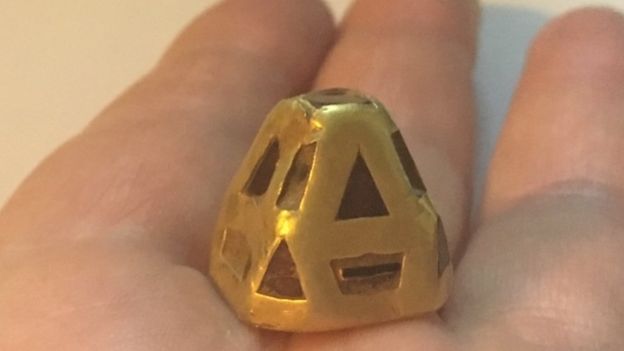Pani ma na hledani super boty 
She inherited a detector and found two Anglo-Saxon objects worth half a million
Categories: Finds and rescue research abroad , Nálezy nejenom s detektorem ve Velké Británii a Irsku
Fifty-four-year-old Mel Hollwoger had the great fortune of a beginner when she inherited a metal detector and, during her firstthree months near her home in Aldborough, Norfolk, she found two very rare Anglo-Saxon artefacts.
Mrs Hollwoger's partner has been a detectorist for many years. He and his father, who has been searching for a quarter of a century, have been going on adventurous expeditions together since they were young. In 2018, his father died and the detector remained unused. After some time, Mel borrowed the detector and found that searching was really fun. Although a complete novice, on one of her first expeditions two days before Christmas she found a rare gold pyramid containing garnets from an Anglo-Saxon sword scabbard. A few weeks later she found another gold artifact, this time an ornate gold Anglo-Saxon belt in the shape of a ring. As she put it, "At first it was a huge joke - a classic case of beginner's luck, but to find another artefact like this is really beyond belief".
According to PAS, the gold pyramidal sword scabbard dates from between the mid-sixth and late seventh centuries. The function of the pyramid was probably to prevent the sword from accidentally falling out of the scabbard. Some 50 similar artefacts have been found in England, of which only 5 are gold, one of which was part of the Staffordshire Hoard. The gold decoration with garnets refers to the high status of its owner.
At the time of the find, Mrs Hollwoger was a guest of the Norfolk Recovery Heritage Group (NRHG), whose representatives had never experienced anything like it before. "Most of us can search all our lives and never even come close to a find of this significance, but to find two such rareimportant artefacts from the Saxon period and from different locations is almost unheard of," said Rick Child of the NRHG Detector Group.
Both objects were recently declared treasures. The gold pyramid was valued at £25,000 (about 740,000 kroner) and the gold belt is expected to be valued at a similar amount. In total, therefore, about one and a half million crowns, which the finder is expected to split with the landowner. However, historians are still not sure what the belt was supposed to be used for, it was probably some kind of decoration, perhaps a cross or a sword...of an ornate Christian cross, the gold belt could be even more valuable in light of the development and gradually growing influence of Christianity in the Anglo-Saxon world.
The Norfolk Museums Service originally wanted to purchase the pyramid, but withdrew its plan after the British Museum's valuation, given budget constraints. Mrs Hollwoger hopes the object will eventually be purchased by a benefactor and remain in the county where it was found. "In my opinion, it belongs to Norfolk. It's our history, everyone's history." The detective eventually added that she hopes to find "something Celtic" next time.
Roman Nemec




Sources: edp24.co.uk, bbc.com
The article is included in categories:
- Archive of articles > Archaeology > Finds and rescue research abroad
- Archive of articles > Archaeology > Finds and rescue research abroad > Nálezy nejenom s detektorem ve Velké Británii a Irsku
Post
Najít něco takového je u nás spíš důvod k breku. Nechat si to člověk nesmí a ani za to pravděpodobně nic nedostane, natož majitel pozemku.
Super nález ad to milé paní pípa 
Já trouba chodím na hledačku v gumákách nebo vojenských botách - tak proto nemůžu nic pořádného najít, je to všechno o správném výběru bot 
 ...
...
To je paráda no.Jdu si rychle obednat nejaky pohodlny backurky 
A těžkej nesouhlas s bobikem
No to je zajímavý příběh. Ale teď potom zveřejnění a udání místa to je asi jak na výstup na Sněžku









